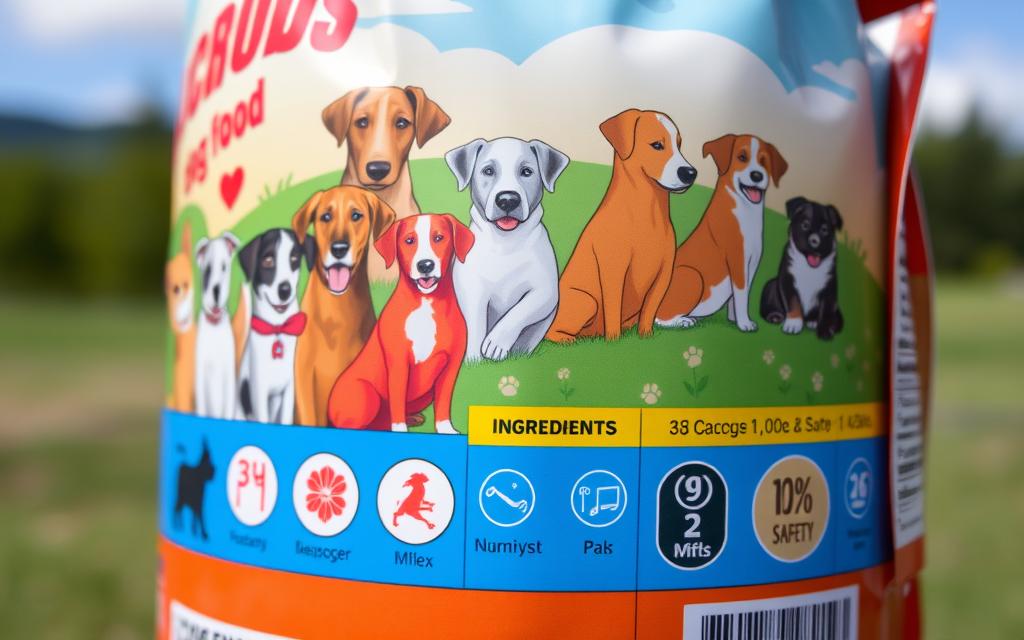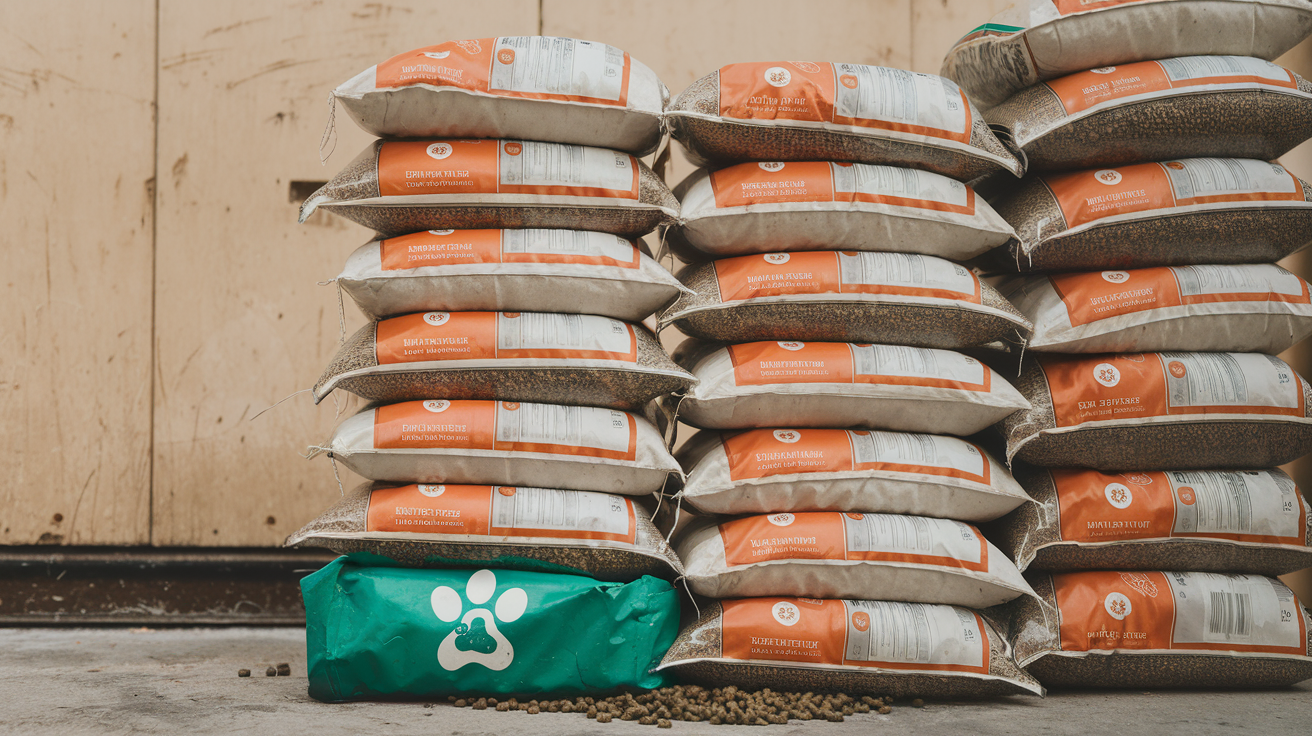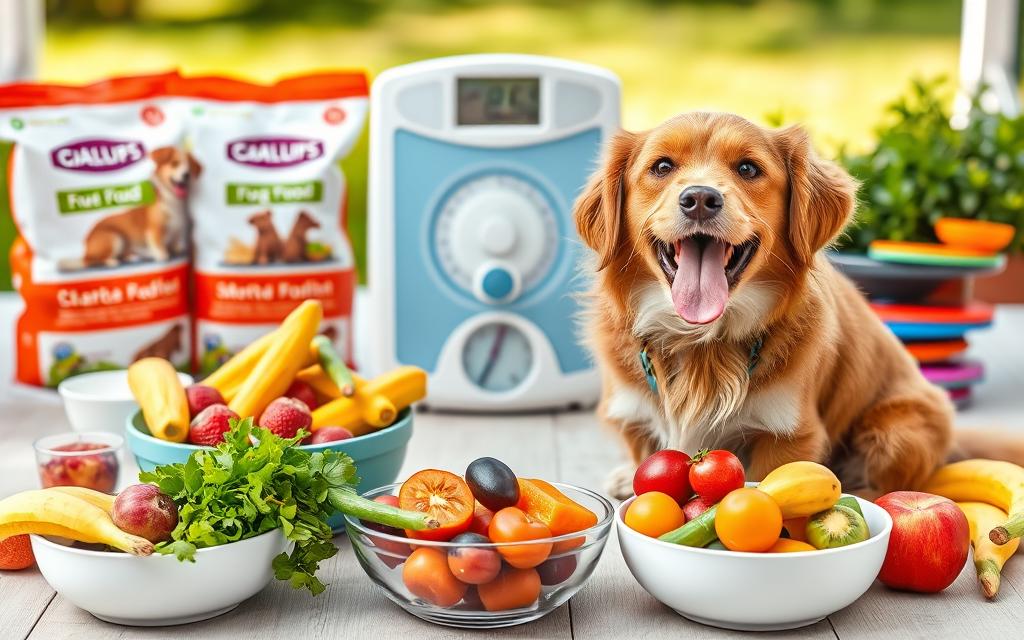I love giving my dog the best food. But, dog food labels can be tricky to understand. They use confusing terms and make claims that aren’t always true. I want to help you read these labels better. This way, you can choose the best food for your dog’s health and happiness.
Key Takeaways
- Understand the essential components of dog food labels, including product name, quantity, manufacturer information, and guaranteed analysis.
- Learn to interpret the ingredient list and identify potential red flags like artificial preservatives or questionable sources.
- Decipher marketing claims like “natural,” “organic,” and “human-grade” to separate fact from fiction.
- Recognize the importance of the nutritional adequacy statement and feeding guidelines for your dog’s specific needs.
- Stay informed about the latest regulations and developments in the pet food industry to make the best choices for your furry friend.
Essential Components of Dog Food Labels
Understanding dog food labels is key when choosing the right food for your pet. Labels tell you about the product name, net weight, and who made it. Each part of the label gives you important info about the food’s quality and if it’s right for your dog.
Product Name and Brand Information
The name of the dog food can hint at what’s inside. AAFCO has rules for names, like the 95% Rule and 25% Rule. These rules help make sure the name is honest and shows what’s in the food.
Quantity and Net Weight Details
The amount of dog food is another key part of the label. It helps you see how much you get for your money. You can look at the cost-per-ounce or cost-per-pound to compare prices.
Manufacturer Information and Date Codes
Knowing who made the dog food is important. The sell-by or best-used-by dates show when it’s fresh. This helps keep your dog healthy and safe.
| Label Component | Purpose |
|---|---|
| Product Name | Provides insights into the ingredient composition and nutritional profile of the dog food |
| Net Weight | Allows for cost comparison between different dog food products |
| Manufacturer Information | Identifies the source and quality control of the dog food |
| Expiration Dates | Ensures the dog food maintains its nutritional value and safety |
Understanding Dog Food Labels: What to Look for and What to Avoid
Choosing the right dog food means reading the labels carefully. Look for the Association of American Feed Control Officials (AAFCO) statement. This shows if the food is “complete and balanced.” Also, check if it’s for growth, maintenance, or all life stages.
Avoid foods without clear nutritional statements or vague claims. In Canada, the Canadian Veterinary Medical Association Seal of Certification is helpful. It shows the product meets quality standards.
Be wary of foods with too many marketing claims or missing nutrient info. Instead, aim for a balanced diet that fits your dog’s needs. Consider their breed, age, and activity level. With some effort, you can give your dog the nutrition they need.
| Nutritional Adequacy | Life Stage Formulations | Certifications |
|---|---|---|
| Look for the AAFCO statement | Options for growth, maintenance, and all life stages | Canadian Veterinary Medical Association Seal of Certification |
| Avoid vague claims | Match your dog’s specific needs | Indicates meeting quality standards |

For a healthy, happy dog, choose a nutritionally adequate food. By reading labels well, you can make a smart choice. This ensures your dog gets the best nutrition.
Decoding the Guaranteed Analysis
The guaranteed analysis on a dog food label is key. It shows the nutrient content of the product. This section lists the minimum percentages of crude protein and crude fat. It also shows the maximum percentages of crude fiber and moisture. Knowing these values helps you compare different dog foods and ensure your dog gets the right nutrients.
Protein and Fat Content Requirements
AAFCO guidelines say dry dog foods must have 18-30% crude protein and 8-15% crude fat. Wet or canned dog foods need at least 5-12% crude protein and 3-8% crude fat.
Moisture and Fiber Levels
The guaranteed analysis also shows the maximum levels of crude fiber and moisture. Dry dog foods can have no more than 2-5% crude fiber and 10-12% moisture. Wet or canned dog foods usually have 1-4% crude fiber and 60-75% moisture.
Additional Nutrient Guarantees
Some dog food labels also list additional nutrients. This includes minimum levels of vitamins, minerals, and other essential nutrients. These extra guarantees help you understand the dog food’s nutritional profile better.
| Nutrient | Dry Dog Food | Wet/Canned Dog Food |
|---|---|---|
| Crude Protein (min) | 18-30% | 5-12% |
| Crude Fat (min) | 8-15% | 3-8% |
| Crude Fiber (max) | 2-5% | 1-4% |
| Moisture (max) | 10-12% | 60-75% |
Understanding the guaranteed analysis helps you choose the best dog food for your pet.
Ingredient List Interpretation
Understanding dog food labels starts with the ingredient list. Ingredients are listed in order of weight, with the first item being the largest part. This order helps us see what’s in the food.
But, ingredient order isn’t everything. Manufacturers might split similar ingredients to make them seem less important. Yet, looking at the nutrient profile gives a clearer picture of the food’s quality.
- Common names must be used for ingredients, as defined by the AAFCO.
- Byproducts and meat meals are actually good, despite what you might think. They’re packed with protein and other important nutrients.
- AAFCO has clear definitions for ingredients. This helps us know what’s really in the food.
Don’t assume the first ingredient is the main one. After moisture is removed, it might not be. A complete look at the ingredient list and the nutrient profile is key. This way, you can choose the best food for your dog.

Nutritional Claims and Marketing Terms
Choosing the right dog food can be tough. It’s important to know the difference between “natural,” “organic,” and “grain-free.” This helps you make the best choice for your pet’s diet.
Understanding “Natural” vs “Organic”
“Natural” on a dog food label means it lacks artificial colors, flavors, and preservatives. But, it doesn’t mean it’s organic. For a dog food to be organic, it must have at least 95% organic ingredients. It also has to meet the USDA’s National Organic Program standards.
Grain-Free and Novel Protein Claims
Grain-free dog foods are popular, but their health benefits are not well proven. Some studies suggest they might increase heart disease risk in certain breeds. Novel proteins like venison or kangaroo might help dogs with sensitivities. Yet, they might not be digestible for all dogs.
Complete and Balanced Statement
The “Complete and Balanced” statement on a label is key. It shows the food meets AAFCO’s nutritional standards. This ensures your dog gets all the nutrients they need. Be cautious of health claims without scientific backing.
It’s vital to understand dog food labels to ensure a healthy diet for your pet. Always talk to your vet to find the best food for your dog’s needs.
| Claim | Definition | Considerations |
|---|---|---|
| Natural | Made without artificial colors, flavors, or preservatives | Does not necessarily mean “organic” |
| Organic | At least 95% organic ingredients, meeting USDA standards | Ensures strict guidelines for organic production |
| Grain-Free | Contains no grains, such as corn, wheat, or rice | Limited scientific evidence on benefits; potential heart risks |
| Novel Proteins | Protein sources not commonly used in pet food, such as venison or kangaroo | May have different digestibility profiles |
| Complete and Balanced | Meets AAFCO nutritional standards for a specific life stage | Ensures all essential nutrients are provided |
Conclusion
Understanding dog food labels is key. By comparing foods on a dry matter basis, you get a clearer picture of their nutrients. It’s also important to talk to your vet to find the right food for your dog’s needs.
Look for dog food with science-backed nutrition, not just marketing. This way, you can avoid giving your dog too little or too much of what they need. By reading labels carefully, you can choose the best food for your dog’s health.
Knowing how to read dog food labels is crucial. It helps you give your dog the right food for a happy, healthy life. With the right knowledge and vet advice, you can make sure your dog gets the nutrition they need.




